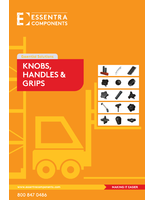Data Module mitigates critical materials risk.
Share:
Press Release Summary:
Part of GRANTA MI software, Critical Materials Data Module includes supply risk data for 67 key elements. Data records describing those elements are linked to records describing materials in which elements can be found, allowing at-risk materials to be identified. Price volatility and variation data help assess potential impact of future price fluctuations. Data-driven assessment of materials supply and environmental risks helps design-out problems and meet legislative requirements.
Original Press Release:
New Data Module Mitigates Critical Materials Risk through Material Intelligence
Data-driven assessment of materials supply and environmental risks helps design-out problems and meet legislative requirements
Cambridge –Granta Design, the materials information technology experts, today announced the availability of a new Critical Materials Data Module within the GRANTA MI materials information software. Development of this resource has been driven by the SAMULET project, a Rolls-Royce-led collaborative programme, which held its concluding meeting this week. The new Data Module responds to growing awareness of the business risks relating to ‘critical’ elements. It will help engineering organizations respond to legislation such as the US Dodd-Frank Act and to critical materials lists such as those highlighted in the 'Critical Raw Materials for the EU' report, which have put critical materials and conflict minerals under greater scrutiny.
Critical materials are those, such as rare earth elements, where material supply is at risk due to factors such as geopolitical risk, environmental country risk, physical scarcity, conflict minerals, and price volatility. The new data module enables a fully quantitative assessment of these factors. Together with Granta’s tools for supporting optimal material and processing decisions, this allows mitigating action to be taken early in the product design process, meaning that the true risks and costs associated with using these materials are understood, and can be minimized.
To support such data-driven assessment, the Critical Materials Data Module includes supply risk data for 67 key elements. The data records describing those elements are linked to records describing the materials (for example, aerospace alloys) in which the elements can be found, allowing at-risk materials to be quickly identified. Price volatility and price variation data help assess the potential impact of future price fluctuations. This information is supported by an elemental supply risk rating methodology, developed through industry-led research to ensure a practical, action-focused approach for risk mitigation.
These tools are the product of Granta’s involvement in the Rolls-Royce-led SAMULET project, which was supported by funding from government and industry, including the UK Technology Strategy Board and the Engineering and Physical Sciences Research Council (EPSRC). The latest phase focused on providing the aerospace industry with tools to manage restricted substances, critical materials, and energy usage as they seek to manufacture greener engines for the next generation of civil aircraft. In particular, it sought to address concerns including:
- costly product redesign due to substance, material, or process obsolescence.
- security of supply and fluctuating prices (for both energy and materials).
- potential costs of non-compliance with legislation.
- undocumented change in the supply chain.
The SAMULET project highlighted that, although many of these risks are long-term, developing over a period of years rather than months, they need to be considered today when designing aerospace products. These products have very long design cycles and service lives, meaning they are likely to be affected by these supply disruptions or evolving environmental legislation over the course of their lifetime. Understanding exposure to these risks and mitigating them, preferably early in the product design, must be part of ‘business as usual'. Availability of this data within the GRANTA MI software, which makes it available on engineers’ desktops, and even integrates with corporate CAD and PLM systems, provides a framework to ‘design out’ risk.
Â
“Alleviating business risks associated with critical materials requires detailed understanding of the sources of those risks”, commented Granta’s Dr. James Goddin, Project Manager for Collaborative Research and Development. “We are delighted that our involvement with leading industrial and academic partners has led to the development of these much-needed information resources, enabling the quantitative risk assessment required for strategic responses to critical material risks.”
GRANTA MI is a trademark of Granta Design Limited.
About Granta
Granta Design Limited is the materials information technology expert. Granta develops the leading software for materials information management in engineering enterprises, and the leading teaching resource for materials engineering education. Granta serves sectors as diverse as aerospace, defense, energy, medical devices, automotive, manufacture of consumer and industrial equipment, materials production, and publishing. Customers realize multi-million dollar benefits in reduced cost, enhanced product performance, improved quality, and faster design turnaround. Granta was founded in 1994 as a spinout from the University of Cambridge and the work of Professors Mike Ashby and David Cebon.
About SAMULET
The SAMULET industry-academic collaborative programme was led by Rolls-Royce and involved other high-profile manufacturers, Small and Medium Sized Enterprises (SMEs), and several of the UK’s top universities. It received significant funding from industry, the UK Technology Strategy Board, and the Engineering and Physical Sciences Research Council (EPSRC). SAMULET aimed to ensure that the aero-engine industry remains competitive in the face of 2020 emissions targets for aircraft and that it is in a position to manufacture engines for the next generation of civil aircraft. Granta’s involvement focused on providing materials eco-design and selection activities.
Further information
Supporting images and html version of this release: www.grantadesign.com/news/media.htm
Granta can assist publications or websites wishing to review our software – please contact us.
More information on Granta: www.grantadesign.com
Granta’s Critical Materials Data Module: www.grantadesign.com/products/data/critical.htm




